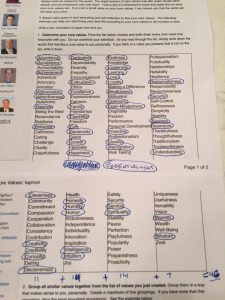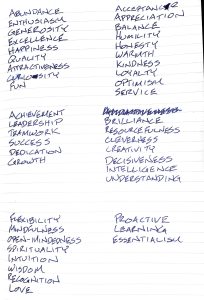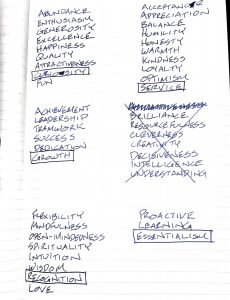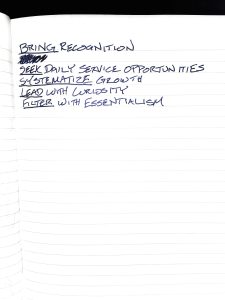By
Austin Collins
Did you know you have a personal advisory board? There are 5 people in your life, right now, who collectively have an enormous impact on your attitude, motivation and mindset. Who are these people? Simple. The 5 people you spend the most time with. Here’s a subtle but significant truth that transforms this concept into a life changing opportunity: You don’t have to know someone personally for them to be in your “Top 5.” You have more control over your Top 5 than you think. I will show you how to leverage this control to recruit virtually anyone in the world to your team.
“You are the average of the 5 people you spend the most time with.” – Jim Rohn, Motivational speaker
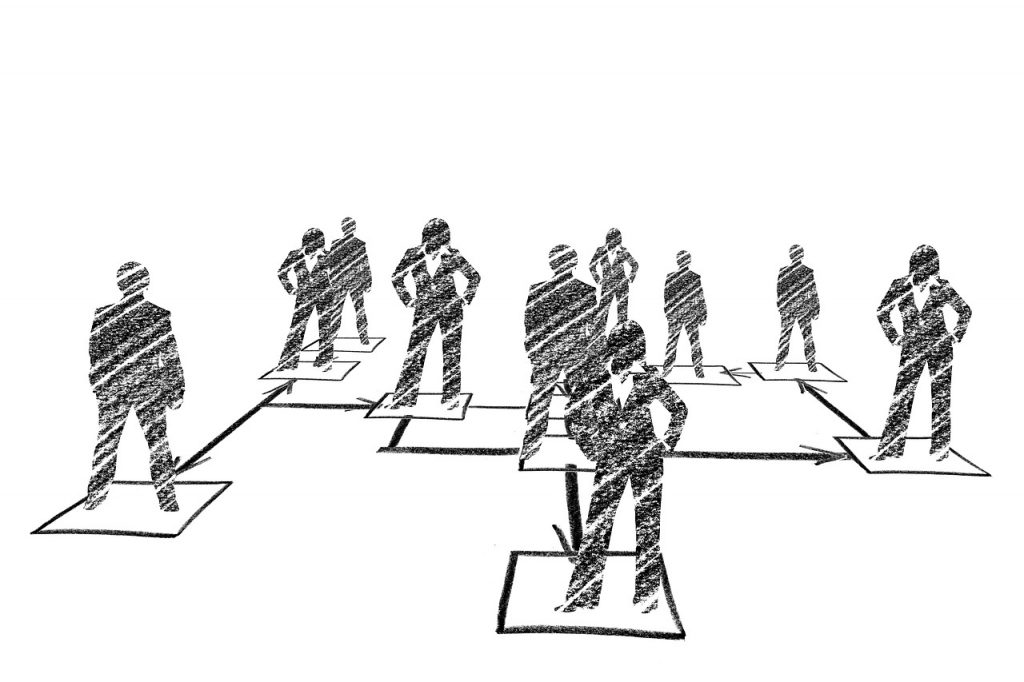
This is one conceptual iteration of what is sometimes referred to as the Law of Averages. It’s actually not a law at all as far as science or mathematics are concerned. Despite it’s inaccurate title, it is very powerful when applied correctly.
Over the last year I have been experimenting with my own Top 5. Surrounding myself with different people has increased optimism, mindfulness, and discipline. I’m also more curious, so I ask better questions and have become a better listener. These changes are not fleeting. The reality is just the opposite. These elements of my life have shifted sustainably, and with momentum that continues to increase!
Why does this principle work? What makes it so high impact? These 2 brain functions are at the top of the list.
- Brain plasticity: We can’t change our genetic hardware. But thanks to a beautiful quality of our brains, called “plasticity,” we can gradually change our operating system. This summary from a US Institute of Medicine Forum on Neuroscience offers a concise description: “…there is a back and forth pattern between nature and nurture, a dynamic system that involves a continuous feedback loop shaping the physical structure of our brains.” That’s why a carefully crafted Top 5 strategy is so profound. You simultaneously create a force multiplier for your actions AND physically change your brain to see the world in a way that serves your vision. In other words, you get to design your own self fulfilling prophecy!
- Reticular activation system (RAS): Your RAS is believed to control a number of critical brain functions. One of it’s responsibilities is to filter your perceptions of the world and guide your attention to the important data. This article from the SOAR library on Aviation lays it out well: “The RAS operates a lot like a spam filter that really works, and only brings to your attention email that you need to pay attention to.” I program my RAS every morning by listening to James Altucher for 40 minutes during my commute. He asks brilliant questions and learns amazing lessons from his guests. For the rest of the day, my RAS looks for opportunities to ask questions and learn from the people around me. But be careful, because the opposite is also true. For example, an argument filled political radio show will program my RAS to search for opportunities to disagree with everyone.
The world around us is the same either way. Using a different lens changes our experience. We have the right hardware built in to our heads. Changing our Top 5 upgrades our software to take advantage of it!
In the Personal Leverage™ framework, you deliberately seek out and consume content that aligns with your values and intentions. When you take action, you leverage the experience, perspective & wisdom of others. The alignment from this system creates a force multiplier that compounds over time, propelling you toward your personal purpose.
The 5 people you spend the most time with are collectively responsible for a huge portion of the content you consume. If you change this group of people, you change your life. Period.
Here is a high level illustration of the process I developed, which is explored in detail later in this post.

There have been a number of insightful articles written on this concept over the last few years from sources such as Lifehacker, Personal Excellence, and entrepreneur.com. They make great points and suggest relevant considerations for how to think about this concept. My intention is a bit different. I’m focused much less on educating you about the so called “Law of Averages.” Instead, this post is about 2 things:
- Exploring the “force multiplier” effect produced by applying this Top 5 concept in coordination with a higher order life strategy, like the Personal Leverage™ model.
- Sharing a repeatable, step by step process for implementing this concept.
You can use this post to hit the ground running, with a road map to take action immediately and effectively. If you are looking for more leverage in your life right now, this post is for you. For additional perspective, I encourage you to read the other posts mentioned above.
So how do you take control of your Top 5 and change your life? The entire process is outlined step by step below. Consider using either a mind map or a spreadsheet for this exercise. You can find my complete mind maps for each step of the entire process by clicking on the title of each step below. This is a start to finish process checklist for crafting a Top 5 strategy.
Each step below contains a link to a mindmap. These maps are my personal templates for completing each step. Use them as a starting point and adapt as necessary.
1. Acknowledge that you are a sponge. Think about it. Do you ever notice your attitude or vocabulary changing as you spend more time with different people? What else might you be picking up without realizing it?
I’m definitely a sponge – soaking up the mindset, vocabulary and emotional proclivities of people around me. As soon I embraced this reality, I tapped into a well of motivation that helped me keep up momentum as I began to change my Top 5.
2. What is the ideal outcome of changing your top 5? In his New York Times bestseller, Simon Sinek sagely suggests that you always “Start with Why.” I could not agree more. Why do you want to change your Top 5? Here are 2 questions to help crystallize your own personal “why.”
- What are your personal values? Values are a customized compass. In this case, they are instrumental in the pursuit of the right Top 5. If it’s been a while since you clarified the most important themes in your life, this is a perfect time to revisit them. I recommend this quick values exercise.
- If you could change 1 thing about the way you see the world, what would it be? Would you be an optimist, a better conversationalist, a better listener, more spiritual, etc…
My desired outcomes were to become a better problem solver, increase my self confidence and connect with new ideas & perspectives.
3. How is your time spent today? In order to determine who makes up you current Top 5, you must first understand where you spend your time. Take your weekly totals for the last month and average them. If the last month was odd for some reason, you can use a different time frame (next month, last quarter, etc). Take another look at my mind map for this step to see an example of this time inventory.
I found that my time is concentrated in 2 places: work & home. But the people I spend time with at work change from week to week. As a result, my Top 5 is fragmented and therefore easy to change.
4. Who are your Top 5 right now? Make a list of your Top 5 and the number of hours per week you spend with each of them. The beauty of this exercise is that you can make your own rules so they fit you perfectly. Here are a couple guidelines that helped me:
- Only adults are eligible for Top 5 status
- Teams count as a single person if interaction is mostly group based (work meetings, group collaborations, etc…)
- How much time per week would it take to replace the bottom person on that list?
How many hours per week would it take for someone to get into your Top 5?
My time tends to be fragmented across a landscape of people that changes from week to week. Thus, in order for me to get someone new into my Top 5, it only takes 2 hours per week.
5. Where and how can you consume content? Since the goal is consistent exposure to specific people, podcasts are naturally compelling. Find a Top 5 candidate who has lots of podcast episodes. That person now curates fresh content for you on a daily basis. How much better could it get? Audiobooks, blogs and physical books can be very effective as well.
I spend about 7.5 hours every week in my car. It would be easy to think of this as “wasted time” and end up feeling depressed. Instead, I choose to see this as an amazing opportunity to change my Top 5!
6. Finalize your strategy. By this point, you know how much time is needed to replace your #5. You also already know when, where and how you can “spend time” with new Top 5-ers. Nothing left to do but execute!
After you have selected the newest member of your Top 5, download a week’s worth of podcasts, an audiobook or RSS feeds to have Siri read to you. Check out Amazon’s Whispersync for voice. The more options you know about for accessing information, the more likely you are to find the one that fits you best. Put time with your Top 5 on your calendar to remind yourself, and to create the space to execute. What gets scheduled gets done.
I chose to add Jocko Willink and James Altucher to my team. Their podcasts can be heard every day in my car.
7. Enjoy your new team – your new Top 5!
Do you have any experience applying the Top 5 strategy? Feel free to share your experience with this or ask questions in the comments. I would love to hear from you!





